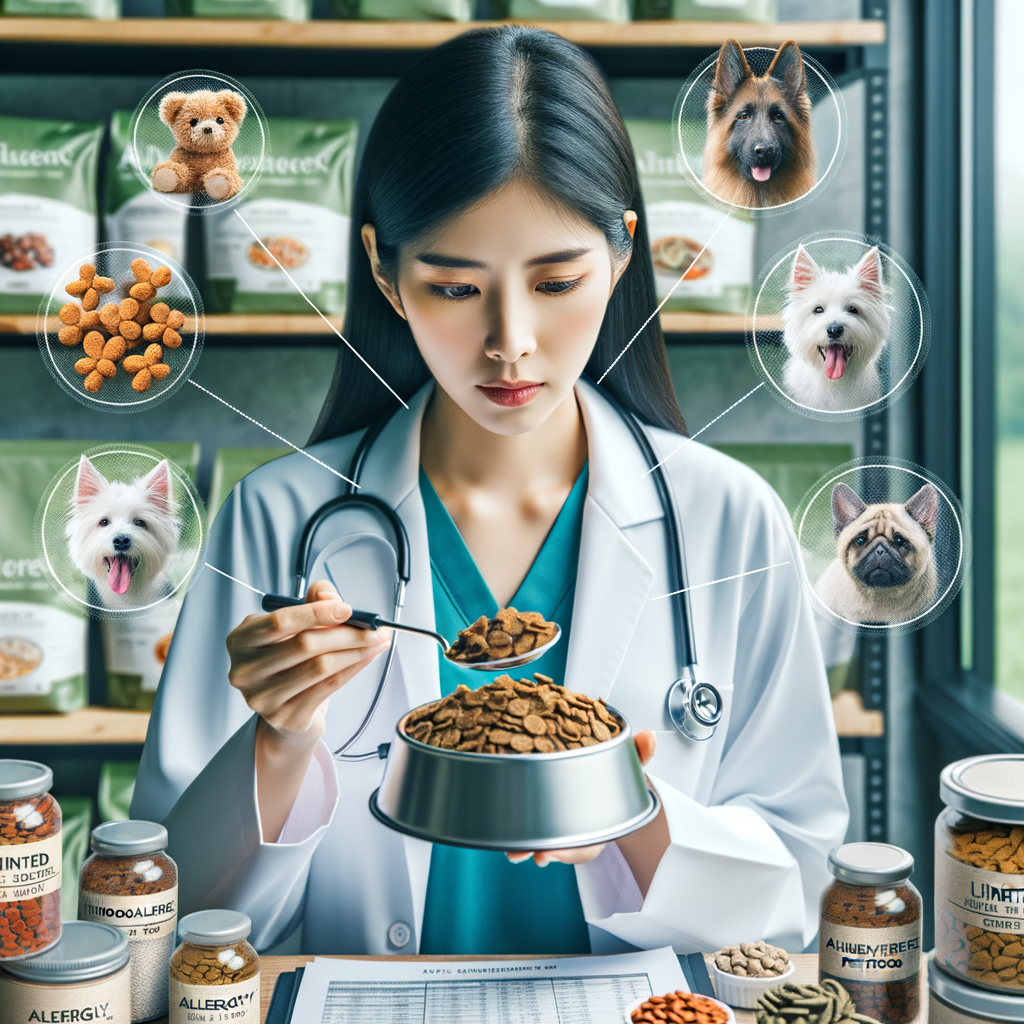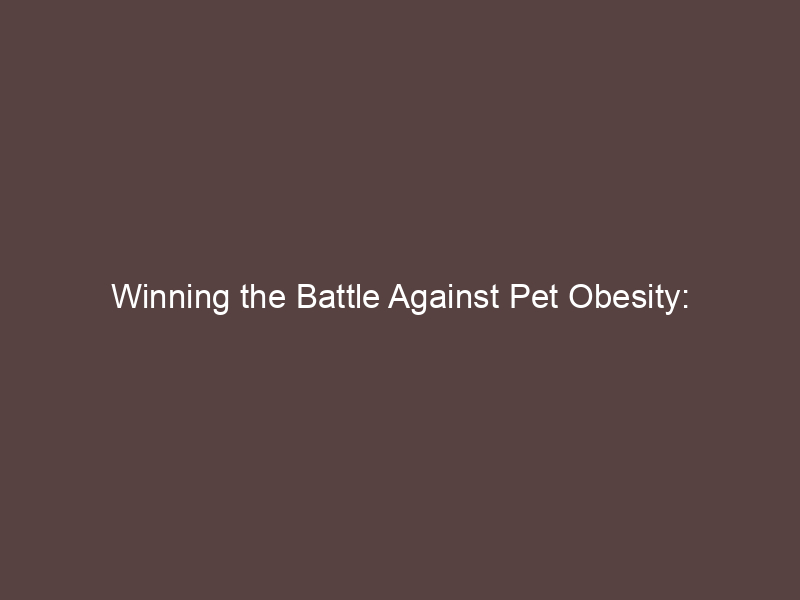
Introduction to Limited Ingredient Diets for Pets
When it comes to our pets’ health, nutrition plays a pivotal role. One of the trending topics in pet nutrition today is the concept of Limited Ingredient Diets. In this section, we will delve into what Limited Ingredient Diets are and the benefits they offer to our furry friends.
- Definition of Limited Ingredient Diets
- Benefits of Limited Ingredient Diets for Pets
A Limited Ingredient Diet for pets is a type of diet that contains fewer components compared to regular pet food. The idea behind this diet is to limit the number of ingredients pets consume, making it easier to identify any food allergens or sensitivities. These diets typically include a single source of animal protein and a few other essential components, eliminating unnecessary additives and fillers.
There are several benefits to feeding your pet a Limited Ingredient Diet. Firstly, it can help identify food allergies or sensitivities. By limiting the number of ingredients, it becomes easier to pinpoint what might be causing your pet discomfort. Secondly, these diets often contain higher quality ingredients, which can lead to better overall health. For instance, a diet with a single source of high-quality protein can promote lean muscle development and a healthy coat. Lastly, Limited Ingredient Diets can aid in digestion. Fewer ingredients mean less work for your pet’s digestive system, which can be beneficial for pets with sensitive stomachs.
In the following sections, we will explore more about pet sensitivities and allergies, hypoallergenic pet food, and the differences between natural and commercial pet food. We will also delve into the topic of grain-free pet diets and provide a comprehensive understanding of pet nutrition. Stay tuned to learn more about how to manage your pet’s dietary restrictions effectively and discover the magic of Limited Ingredient Diets for sensitive pets.
Understanding Pet Sensitivities and Allergies
Our pets are an integral part of our lives, and just like us, they can also suffer from sensitivities and allergies. These can be caused by a variety of factors, and it’s important to understand them to provide the best care for our furry friends.
Common Pet Sensitivities
There are two main types of sensitivities that can affect our pets: food allergies and environmental allergies. Let’s take a closer look at each of these.
- Food Allergies
- Environmental Allergies
Food allergies in pets can be caused by a variety of ingredients. The most common culprits are proteins found in beef, chicken, dairy, and wheat. Symptoms can include skin irritations, gastrointestinal issues, and even behavioral changes. It’s estimated that food allergies account for about 10% of all allergies in dogs and cats.
Environmental allergies, also known as atopy, can be triggered by a variety of factors including pollen, dust mites, mold, and even certain fabrics. These allergies can cause a range of symptoms, from skin irritations and respiratory issues to ear infections. According to a study, about 15% of dogs suffer from environmental allergies.
Understanding these sensitivities is the first step towards managing them effectively. By identifying the triggers and symptoms, we can take steps to reduce our pets’ exposure to allergens and provide them with a more comfortable life.
Identifying Allergies in Pets
Just like humans, our furry friends can also suffer from allergies. Identifying these allergies in pets can be a challenge, but with careful observation and professional help, it is possible. In this section, we will discuss the common symptoms of pet allergies and how to diagnose them.
- Common Symptoms of Pet Allergies
- Excessive scratching or licking
- Red, inflamed skin
- Chronic ear infections
- Sneezing, coughing, or wheezing
- Vomiting or diarrhea
- Diagnosing Pet Allergies
When a pet has an allergy, it can manifest in a variety of ways. Some of the most common symptoms include:
These symptoms can be distressing for both the pet and the pet owner. It’s important to remember that these are signs that your pet’s body is trying to rid itself of something it considers harmful.
Diagnosing allergies in pets can be a complex process. It often involves a combination of a thorough physical examination, a detailed history of the pet’s health and symptoms, and specific allergy tests. These tests may include skin tests or blood tests. In some cases, a food elimination diet may be recommended to identify food allergies.
It’s important to consult a veterinarian if you suspect your pet has an allergy. They can provide the necessary tests and treatments to help your pet feel better.
Understanding your pet’s allergies is the first step towards managing them effectively. By recognizing the symptoms and seeking professional help for diagnosis, you can ensure your pet gets the care it needs to live a happy, healthy life.
Hypoallergenic Pet Food and Its Benefits
When it comes to our furry friends, we want to provide the best for them. This includes their diet. One type of food that is gaining popularity among pet owners is hypoallergenic pet food. But what exactly is it and what are its benefits? Let’s dive in and find out.
- What is Hypoallergenic Pet Food?
- Benefits of Hypoallergenic Pet Food for Sensitive Pets
- Reduced Allergic Reactions: By eliminating common allergens, hypoallergenic pet food can help reduce or eliminate allergic reactions in your pet.
- Improved Digestive Health: These foods are easier for your pet to digest, which can lead to improved gut health and fewer digestive issues.
- Better Skin and Coat Health: Many pets with food allergies experience skin and coat problems. Hypoallergenic pet food can help improve skin and coat health, leading to a shinier coat and less itching and scratching.
- Increased Energy Levels: With a diet that’s easier to digest, your pet may have more energy and vitality.
Hypoallergenic pet food is a type of diet designed for pets who have food sensitivities or allergies. These foods are made with limited ingredients and exclude common allergens like wheat, soy, dairy, and certain types of meat. The goal is to provide a balanced diet that is gentle on your pet’s digestive system.
Feeding your pet hypoallergenic food can have several benefits, especially if they have a sensitive stomach or food allergies. Here are a few key benefits:
In conclusion, hypoallergenic pet food can be a great choice for pets with food sensitivities or allergies. It’s designed to be gentle on your pet’s system, while still providing all the nutrients they need. As always, it’s important to consult with your vet before making any major changes to your pet’s diet.
Natural Pet Food vs. Commercial Pet Food
When it comes to feeding our pets, we all want the best for them. But what exactly does that mean? Is it better to stick with commercial pet food brands that have been around for years, or should we opt for natural pet food? Let’s delve into the benefits of natural pet food to help you make an informed decision.
Benefits of Natural Pet Food
Natural pet food has several advantages over commercial pet food. Here are some of the most notable benefits:
- High Nutritional Value
- Less Likely to Cause Allergic Reactions
Natural pet food is typically made with high-quality ingredients, which means it’s packed with the nutrients your pet needs. Unlike some commercial pet foods, which may use fillers and by-products, natural pet food often contains whole foods like meat, vegetables, and grains. This can result in a higher nutritional value, providing your pet with the vitamins, minerals, and other nutrients they need to stay healthy.
Many pets suffer from food allergies, which can cause a variety of symptoms ranging from skin irritation to digestive issues. Natural pet food is often free from common allergens like corn, wheat, and soy, making it less likely to trigger an allergic reaction. Plus, because it’s made with whole foods, it’s easier for your pet’s body to digest and absorb, which can also help reduce the risk of allergies.
In conclusion, natural pet food can be a great choice for pet owners who want to provide their pets with a diet that’s both nutritious and less likely to cause allergic reactions. However, it’s always important to consult with your vet before making any major changes to your pet’s diet.
Drawbacks of Commercial Pet Food
While commercial pet food is often a convenient and affordable choice for many pet owners, it’s important to be aware of some potential drawbacks. These can include the presence of potential allergens and a lack of essential nutrients.
- Potential Allergens in Commercial Pet Food
- Lack of Essential Nutrients
One of the most significant concerns with commercial pet food is the potential for allergens. Many commercial pet foods contain common allergens such as wheat, corn, and soy. These ingredients can cause allergic reactions in some pets, leading to symptoms like itching, digestive issues, and skin problems. According to a study by the Journal of Animal Physiology and Animal Nutrition, about 10% of all allergies in dogs are food allergies.
Another drawback of commercial pet food is that it may not provide all the essential nutrients your pet needs for optimal health. Commercial pet foods are often made with fillers and by-products rather than high-quality, nutrient-rich ingredients. This can lead to a lack of essential nutrients like protein, vitamins, and minerals. A study published in the Journal of Nutritional Science revealed that some commercial pet foods do not meet the nutritional standards set by the Association of American Feed Control Officials.
In conclusion, while commercial pet food can be a convenient choice, it’s important to be aware of these potential drawbacks. Always check the ingredients and nutritional information on the pet food label to ensure your pet is getting a balanced diet.
Exploring Grain-Free Pet Diets
As pet owners, we always want the best for our furry friends. One topic that has been gaining attention in the pet food industry is grain-free diets. But what exactly does “grain-free” mean, and is it beneficial for our pets? Let’s delve into this topic.
- Benefits of Grain-Free Diets for Pets
- Improved Digestion: Some pets may not digest grains well, leading to issues like bloating and indigestion. A grain-free diet can help alleviate these symptoms.
- Better Coat Health: Many pet owners report that their pets have shinier coats and healthier skin after switching to a grain-free diet.
- Weight Management: Grain-free pet foods often have higher protein and lower carbohydrate content, which can help pets maintain a healthy weight.
- Potential Risks of Grain-Free Diets
- Nutritional Imbalance: Grains provide essential nutrients that pets need. Without these, pets might suffer from nutritional deficiencies.
- Heart Problems: Some studies have found a potential link between grain-free diets and a type of heart disease in dogs known as dilated cardiomyopathy.
- High in Calories: Grain-free foods can sometimes be higher in calories, which could lead to weight gain if not managed properly.
Grain-free diets for pets have been praised for their potential health benefits. Here are a few key points:
While grain-free diets can offer certain benefits, they also come with potential risks that pet owners should be aware of:
In conclusion, while grain-free diets can offer certain benefits, they are not without risks. It’s important to consult with a veterinarian before making any major changes to your pet’s diet.
Understanding Pet Nutrition
When it comes to our furry friends, providing them with the right nutrition is crucial. Just like humans, pets need a balanced diet to stay healthy and active. Let’s delve into the essential nutrients that every pet needs.
Essential Nutrients for Pets
There are four key nutrients that every pet needs in their diet. These are proteins, fats, carbohydrates, and vitamins and minerals.
- Proteins
- Fats
- Carbohydrates
- Vitamins and Minerals
Proteins are the building blocks of your pet’s body. They help in growth, repair of body tissues, and production of hormones and enzymes. For instance, a study found that dogs need at least 18% protein in their diet, while cats require at least 26%.
Fats provide the most concentrated source of energy for your pet. They also help in the absorption of certain vitamins and add flavor to the food, making it more palatable. A healthy pet diet should contain about 10-15% fat.
Carbohydrates provide energy and help in the functioning of the intestines. While pets don’t necessarily need carbohydrates in their diet, they can be a good source of quick energy and fiber.
Vitamins and minerals are vital for various body functions. For example, calcium and phosphorus are needed for strong bones and teeth, while vitamin A is essential for good vision.
Understanding these essential nutrients can help you make better food choices for your pet. Remember, a well-nourished pet is a happy and healthy pet.
The Role of Nutrition in Pet Health
Just like us, our pets need a balanced diet to stay healthy and active. The role of nutrition in pet health is immense and cannot be overstated. Let’s delve deeper into this topic.
- Importance of Balanced Nutrition
- Impact of Poor Nutrition on Pet Health
A balanced diet is crucial for your pet’s overall health. It provides the necessary vitamins, minerals, proteins, fats, and carbohydrates that your pet needs to function optimally. A balanced diet helps maintain a healthy weight, promotes a shiny coat, strengthens the immune system, and supports the overall well-being of your pet.
For instance, proteins are essential for growth and repair, fats provide energy and help absorb vitamins, carbohydrates provide energy, and vitamins and minerals are necessary for various bodily functions. Thus, a balanced diet is the cornerstone of pet health.
Poor nutrition can have a detrimental impact on your pet’s health. An unbalanced diet can lead to obesity, dental issues, heart disease, and a host of other health problems. For example, a diet high in fats can lead to obesity and related health issues like diabetes and heart disease. On the other hand, a diet lacking in essential nutrients can lead to deficiencies, resulting in poor growth, weak immune system, and a dull coat.
Moreover, poor nutrition can also lead to food allergies and sensitivities, causing discomfort and illness in pets. Therefore, it’s crucial to provide your pet with a balanced diet to ensure their health and longevity.
In conclusion, a balanced diet plays a pivotal role in your pet’s health. It’s essential to provide your pet with a diet that meets all their nutritional needs to ensure they live a long, healthy, and happy life.
Sensitive Stomach Pet Food: What to Look For
When it comes to feeding your pet, it’s crucial to consider their unique dietary needs, especially if they have a sensitive stomach. The right food can make a significant difference in their overall health and happiness. Here’s what to look for when shopping for sensitive stomach pet food.
- Ingredients to Avoid
- Artificial additives: Artificial colors, flavors, and preservatives can cause digestive issues in pets.
- Grains: Some pets may have a hard time digesting grains like corn, wheat, and soy.
- Dairy products: Many pets are lactose intolerant, which means they can’t digest dairy products well.
- Fatty foods: Foods high in fat can lead to pancreatitis, a serious condition that can cause digestive problems.
- Recommended Ingredients for Sensitive Pets
- Lean proteins: Lean meats like chicken, turkey, and fish are easier for pets to digest.
- Easily digestible carbohydrates: Sweet potatoes and brown rice are examples of easily digestible carbohydrates.
- Fiber: Fiber can help regulate your pet’s digestive system. Look for foods with ingredients like pumpkin and peas.
- Probiotics: These beneficial bacteria can help improve your pet’s gut health.
Some ingredients can cause upset stomachs in pets. These include:
On the other hand, there are certain ingredients that can be beneficial for pets with sensitive stomachs. These include:
In conclusion, when choosing food for your pet with a sensitive stomach, it’s important to read the ingredient list carefully. Avoid foods with ingredients that can cause digestive problems, and opt for foods with ingredients that promote good gut health. Remember, every pet is unique, so what works for one might not work for another. Always consult with your vet before making any major changes to your pet’s diet.
Allergy-Friendly Pet Food: A Closer Look
When it comes to our furry friends, we want to ensure they’re not only happy but also healthy. One way to do this is by providing them with allergy-friendly pet food. This type of food is specially formulated to reduce the chances of allergic reactions in pets, making it a great option for pets with known food sensitivities.
- Key Features of Allergy-Friendly Pet Food
Allergy-friendly pet food is designed with specific features to help pets with food sensitivities. These features include:
- Single Protein Source: This type of food typically has one source of animal protein, such as chicken, beef, or fish. This helps to limit potential allergens.
- No Common Allergens: Allergy-friendly pet food is often free from common allergens like wheat, soy, and dairy.
- Natural Ingredients: These foods are usually made with natural ingredients, which can be easier for pets to digest.
- Added Nutrients: Many allergy-friendly foods also include added vitamins and minerals to support overall pet health.
- How to Transition Your Pet to Allergy-Friendly Food
Transitioning your pet to a new type of food should be done gradually to avoid digestive upset. Here’s a simple guide to help you:
- Week 1: Start by mixing 25% of the allergy-friendly food with 75% of your pet’s current food.
- Week 2: Increase the new food to 50% and reduce the old food to 50%.
- Week 3: Now, the new food should make up 75% of your pet’s diet, with the old food making up just 25%.
- Week 4: By this point, your pet should be fully transitioned to the new, allergy-friendly food.
Remember, every pet is unique. If your pet shows signs of discomfort or doesn’t seem to like the new food, it’s best to consult with your vet.
By understanding the key features of allergy-friendly pet food and knowing how to transition your pet to this type of diet, you can help ensure your pet’s health and happiness.
Managing Pet Dietary Restrictions
When it comes to managing your pet’s dietary restrictions, it’s crucial to approach the situation with care and knowledge. Here’s how you can create a diet plan that suits your pet’s needs.
Creating a Diet Plan for Pets with Dietary Restrictions
Creating a diet plan for pets with dietary restrictions involves three key steps. Let’s delve into each of them.
- Consulting with a Vet
- Choosing the Right Food
- Monitoring Your Pet’s Health
Before making any changes to your pet’s diet, it’s essential to consult with a vet. They can provide a diagnosis and guide you on the best dietary adjustments for your pet’s specific needs. Remember, every pet is unique, and what works for one might not work for another.
Once you have your vet’s advice, the next step is choosing the right food. This will largely depend on your pet’s specific dietary restrictions. For instance, if your pet is allergic to grains, a grain-free diet might be the best option. Always opt for high-quality food that meets your pet’s nutritional needs.
After implementing the new diet, it’s crucial to monitor your pet’s health closely. Look out for changes in behavior, energy levels, and physical health. Regular vet check-ups are also essential to ensure the diet is working and not causing any adverse effects.
In conclusion, managing your pet’s dietary restrictions can be a challenge, but with the right guidance and careful monitoring, you can ensure your pet leads a healthy and happy life. Always remember to consult with a vet before making any significant changes to your pet’s diet.
Case Study: Successful Management of Pet Dietary Restrictions
Let’s delve into a real-life example of how dietary restrictions in pets can be managed successfully. This case study revolves around a dog named Max, who had a severe food allergy.
- Background of the Case
- Approach to Dietary Management
- Outcome and Key Takeaways
Max, a 5-year-old Golden Retriever, started showing signs of discomfort after meals. He had frequent bouts of diarrhea, vomiting, and skin rashes. His owners noticed that these symptoms would flare up after he ate certain foods. After consulting with a vet, it was confirmed that Max had a food allergy.
Max’s vet suggested a limited ingredient diet to identify the specific food causing the allergy. The vet recommended starting with a hypoallergenic pet food that contained a single source of protein and carbohydrate. Max’s owners were also advised to monitor his health closely, noting any changes in his symptoms.
After a few weeks on the new diet, Max’s symptoms significantly improved. His owners were able to identify chicken as the allergen causing his discomfort. Max’s case highlights the importance of understanding pet nutrition and the benefits of hypoallergenic pet food. It also underscores the role of a vet in managing pet dietary restrictions.
In conclusion, managing dietary restrictions in pets can be a challenging task. However, with the right approach and guidance, it is possible to ensure your pet’s health and well-being. Remember, every pet is unique and what works for one may not work for another. Always consult with a professional before making any significant changes to your pet’s diet.
Conclusion: The Magic of Limited Ingredient Diets for Sensitive Pets
As we wrap up our discussion, let’s take a moment to appreciate the magic of limited ingredient diets for our sensitive pets. These diets can make a significant difference in the quality of life for our furry friends, especially those suffering from food sensitivities and allergies.
- Recap of the Benefits of Limited Ingredient Diets
- Final Thoughts on Managing Pet Sensitivities and Allergies
Limited ingredient diets offer numerous benefits for pets with food sensitivities. Firstly, they reduce the risk of allergic reactions by limiting the number of potential allergens. Secondly, they can improve digestion, as fewer ingredients mean less strain on the digestive system. Lastly, they can contribute to better overall health, as they often contain higher quality, more nutritious ingredients.
Managing pet sensitivities and allergies can be a challenging task, but with the right diet, it becomes significantly easier. Remember, every pet is unique, and what works for one might not work for another. Therefore, it’s crucial to monitor your pet’s reaction to a new diet and adjust as necessary. Always consult with your vet before making significant changes to your pet’s diet.
In conclusion, limited ingredient diets can be a game-changer for pets with food sensitivities and allergies. They offer a simple yet effective solution to manage these conditions, improving our pets’ health and happiness. It’s truly magical how a simple change in diet can make such a big difference!






